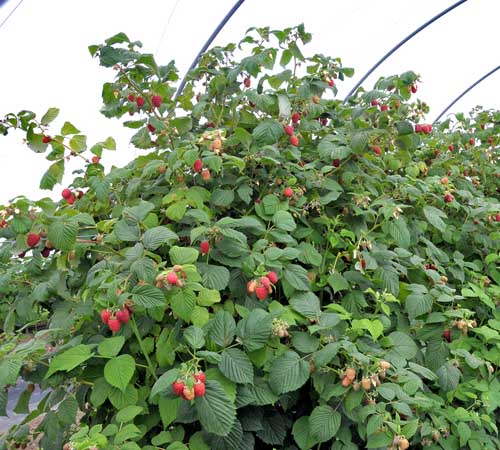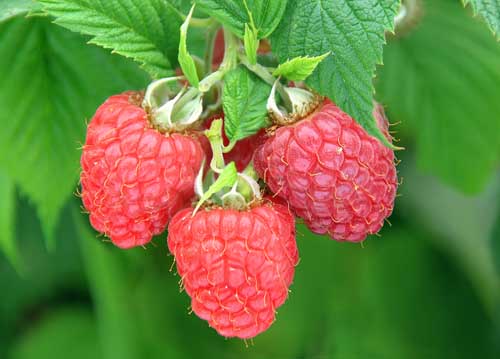Breeding For Quality Improvements In Berry Fruit
Published on 11 February 2010 in Sustainability and Communities , Climate, water and energy , Food, health and wellbeing

Introduction
The majority of fruit consumed in the UK (90%) is imported. There is considerable scope for the continued expansion in UK soft fruit production as currently supply cannot meet demand. Fresh fruit accounts for a market of £4 billion in the UK, and soft fruit/berries account for 16.5% of this. Increased UK production would give greater availability, security and traceability of supply, of a product known to have significant health benefits grown using the most sustainable methods available. Few high quality varieties are available over a wide season and the few that are, have little or no resistance to major pest and diseases.
Consumers are willing to pay a premium for high quality berries and health would benefit from increased consumption. The most important factor for improvement in eating quality is flavour or specifically taste, made up of sweetness and sourness and the balance of these two attributes and overall intensity with impacts from flavour volatiles.
However appearance is as important as taste for initial consumer selection, as only berries of high visual quality will be purchased. Berry size and colouration are the key to consumer success here. Consumer disappointment, given a high price for berries discourages repeat purchases. Better varieties are therefore required that meet quality expectations over a wide season. Given the challenges faced by recent EU legislation (Directive 91/414/EEC, the Sustainable Use Directive) which aims to remove older chemicals and also to satisfy consumer demand for chemical free fruit, breeding for pest and disease resistance is also essential.
Key Points
The availability of soft fruit is essential for health and increasing consumption is a goal for Scottish and UK Governments.
New high quality varieties are required over a wide season with the ability to be grown under low input systems.
New genetic/genomic technologies need to be employed to increase speed and efficiency in breeding programmes.

Photograph: Raspberries growing in a polytunnel.
Research Undertaken
Breeding new high quality raspberries which can be scheduled across a wider season, is a long process hampered by several genetic problems. The changes in environmental, cultural and agronomic practices within the industry will impact strongly on the nature of the germplasm required for the future, with a greater interest in the conservation of genetic resources and utilisation of diverse locally adapted germplasm. Breeding methods used in raspberry have changed very little over the last 40 years and little novel germplasm has made its way into commercial cultivars. However, with the narrowing genetic base coupled with the increasing demands from consumers, new germplasm and breeding methods are required to meet demands.
At SCRI we have identified traits in wild raspberry germplasm that would be of value in commercial production. The speed and precision of breeding can be improved by understanding the genetic control of key traits and the deployment of molecular tools or markers for germplasm assessment and management. Implementation of marker assisted breeding which links easily scorable molecular markers to complex traits can yield defined improvements in fruit quality across the cropping season in harmony with developments of disease resistances and production agronomic traits.
We have developed a number of genetic/genomic tools in the form of mapping populations, linkage maps, large insert DNA libraries and gene expression data which can form the basis of any breeding strategy. Using these technologies, a number of chromosomal locations for key quality traits in raspberry (as well as pest and disease resistance) have been identified and in some cases the major genes responsible for trait variation have been identified. These include steps towards understanding the ripening process which is essential to enable the development of high quality varieties fruiting across a wide season, health aspects, colour and taste.

Photograph: Glen Fyne, a new variety from SCRI, launched in 2008.
Policy Implications
Horticulture is an important component of the Scottish economy and plays an important part in maintaining rural communities. Increasing cultivation of soft fruit crops over a wide season can have benefit here.
Increased availability and consumption of high quality soft fruit varieties will impact on health.
Effective control of soft fruit pest and diseases plays an integral role in maintaining a successful horticultural sector. The new EU legislation (91/414/EEC) will have a profound impact on crop protection and will drive the search for alternatives and the development of low input systems. Resistant varieties would have a significant role here.
Changes in the Scottish climate may exacerbate the effects of pests and diseases. Developing new control strategies against existing and introduced pests/pathogens is therefore a priority.
UK is the third largest net importer of embedded water, of which over half represents horticultural/agricultural products. Cane/bush crops are long lived and lock carbon, minimises soil disturbance and reduce the potential for soil erosion, have low water requirements and allow diversification from more intensive crops.
Author
Dr Julie Graham, SCRI Julie.Graham@scri.ac.uk
Topics
Sustainability and Communities , Climate, water and energy , Food, health and wellbeing







